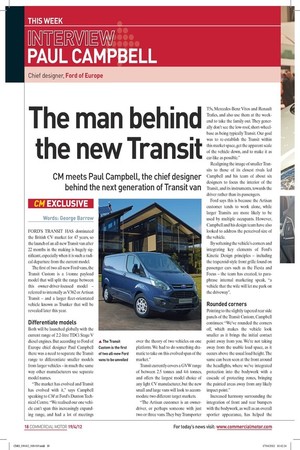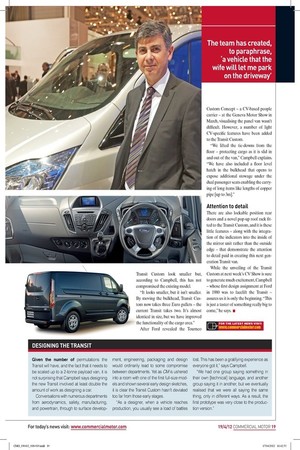The man behind the new Transit
Page 15

Page 16

If you've noticed an error in this article please click here to report it so we can fix it.
CM meets Paul Campbell, the chief designer behind the next generation of Transit van
CM EXCLUSIVE Words: George Barrow
FORD’S TRANSIT HAS dominated the British CV market for 47 years, so the launch of an all-new Transit van after 22 months in the making is hugely significant, especially when it is such a radical departure from the current model.
The first of two all-new Ford vans, the Transit Custom is a 1-tonne payload model that will split the range between this owner-driver-focused model – referred to internally as V362 or Artisan Transit – and a larger fleet-orientated vehicle known as Trunker that will be revealed later this year.
Differentiate models
Both will be launched globally with the current range of 2.2-litre TDCi Stage V diesel engines. But according to Ford of Europe chief designer Paul Campbell there was a need to separate the Transit range to differentiate smaller models from larger vehicles – in much the same way other manufacturers use separate model names.
“The market has evolved and Transit has evolved with it,” says Campbell speaking to CM at Ford’s Dunton Technical Centre. “We realised our one vehicle can’t span this increasingly expanding range, and had a lot of meetings over the theory of two vehicles on one platform. We had to do something dramatic to take on this evolved span of the market.” Transit currently covers a GVW range of between 2.5 tonnes and 4.6 tonnes, and offers the largest model choice of any light CV manufacturer, but the new small and large vans will look to accommodate two different target markets.
“The Artisan customer is an ownerdriver, or perhaps someone with just two or three vans. They buy Transporter T5s, Mercedes-Benz Vitos and Renault Trafics, and also use them at the weekend to take the family out. They generally don’t see the low-roof, short-wheelbase as being typically Transit. Our goal was to re-establish the Transit within this market space, get the apparent scale of the vehicle down, and to make it as car-like as possible.” Realigning the image of smaller Transits to those of its closest rivals led Campbell and his team of about six designers to focus the interior of the Transit, and its instruments, towards the driver rather than its passengers.
Ford says this is because the Artisan customer tends to work alone, while larger Transits are more likely to be used by multiple occupants. However, Campbell and his design team have also looked to address the perceived size of the vehicle.
By softening the vehicle’s corners and integrating key elements of Ford’s Kinetic Design principles – including the trapezoid-style front grille found on passenger cars such as the Fiesta and Focus – the team has created, to paraphrase internal marketing speak, “a vehicle that the wife will let me park on the driveway”.
Rounded corners
Pointing to the slightly tapered rear side panels of the Transit Custom, Campbell continues: “We’ve rounded the corners off, which makes the vehicle look smaller as it brings the initial contact point away from you. We’re not taking away from the usable load space, as it occurs above the usual load height. The same can been seen at the front around the headlights, where we’ve integrated protection into the bodywork with a cascade of protecting zones, bringing the painted areas away from any likely impact point.” Increased harmony surrounding the integration of front and rear bumpers with the bodywork, as well as an overall sportier appearance, has helped the Transit Custom look smaller but, according to Campbell, this has not compromised the existing model.
“It looks smaller, but it isn’t smaller. By moving the bulkhead, Transit Custom now takes three Euro pallets – the current Transit takes two. It’s almost identical in size, but we have improved the functionality of the cargo area.” After Ford revealed the Tourneo Custom Concept – a CV-based people carrier – at the Geneva Motor Show in March, visualising the panel van wasn’t difficult. However, a number of light CV-specific features have been added to the Transit Custom.
“We lifted the tie-downs from the floor – protecting cargo as it is slid in and out of the van,” Campbell explains. “We have also included a floor level hatch in the bulkhead that opens to expose additional stowage under the dual passenger seats enabling the carrying of long items like lengths of copper pipe [up to 3m].”
Attention to detail
There are also lockable position rear doors and a novel pop-up roof rack fitted to the Transit Custom, and it is these little features – along with the integration of the indicators into the inside of the mirror unit rather than the outside edge – that demonstrate the attention to detail paid in creating this next generation Transit van.
While the unveiling of the Transit Custom at next week’s CV Show is sure to generate much excitement, Campbell – whose first design assignment at Ford in 1980 was to facelift the Transit – assures us it is only the beginning. “This is just a taster of something really big to come,” he says. ■











































